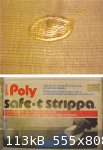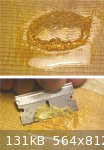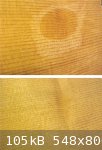Jonathan
Oud Junkie
    
Posts: 1582
Registered: 7-27-2004
Location: Los Angeles
Member Is Offline
Mood: No Mood
|
|
Removing a shellac stain. Polyurethane??
Help! I spilled a small amount of shellac on the face of an oud I just completed. Any suggestions? I've tried acetone, and mineral spirits--no
luck.
I would really appreciate any input
|
|
|
Brian Prunka
Oud Junkie
    
Posts: 2916
Registered: 1-30-2004
Location: Brooklyn, NY
Member Is Offline
Mood: Stringish
|
|
Doesn't alcohol work?
|
|
|
SamirCanada
Moderator
     
Posts: 3404
Registered: 6-4-2004
Member Is Offline
|
|
Alcohol should work.
I have had that happen in the past and I just use a scraper very delicately and it usually takes care of it. the pigements in the schelac dont
penetrate too deep so that is a plus.
@samiroud Instagram
samiroudmaker@gmail.com
|
|
|
Matthias
Oud Junkie
    
Posts: 473
Registered: 1-24-2007
Location: Badenweiler, Germany
Member Is Offline
Mood: No Mood
|
|
it must!!
Matthias
|
|
|
Jonathan
Oud Junkie
    
Posts: 1582
Registered: 7-27-2004
Location: Los Angeles
Member Is Offline
Mood: No Mood
|
|
Crud. That is what I was afraid of.
OK, let me backtrack a little bit on this.
There is the possibility that the stain might be polyurethane. I doubt it, but I am really having a hard time (impossible it seems) removing the
stain with alcohol).
This is an oud that I made in which I initially put on several coats of shellac, then sealed it up with a couple of coats of polyurethane at the
end.
I wasn't crazy about the results, so I ended up sanding the whole thing down, and using just shellac.
I think the stain is shellac, but as I am not having a whole lot of luck removing it, I am starting to wonder if it is actually polyurethane. If that
is the case, is there anything I can do?
I really appreciate your help.
|
|
|
SamirCanada
Moderator
     
Posts: 3404
Registered: 6-4-2004
Member Is Offline
|
|
Polyurethane is sometimes oil based... which if its the case it must be have been soaked in by the absorbant top wood.
I am sorry but I dont know how to remove it... did you try using a cabinet scraper with a light touch?
@samiroud Instagram
samiroudmaker@gmail.com
|
|
|
jdowning
Oud Junkie
    
Posts: 3485
Registered: 8-2-2006
Location: Ontario, Canada
Member Is Offline
Mood: No Mood
|
|
You describe the mark as a stain so the varnish is likely already - to some extent - absorbed into the wood (rather than sitting on the surface as a
coating).
Polyurethane varnish can be removed chemically with methylene chloride based paint/varnish strippers available from most hardware stores. These are
usually gels that are applied over the varnish, allowed to remain for 10 minutes to soften the varnish before the resulting residue is wiped away.
This procedure may have to be repeated to remove all of the varnish after which the surface of the wood should be cleaned with naptha or other solvent
to remove any remaining chemical residues.
The wood surface may then be cleaned up - if necessary - with fine grade steel wool (or with a cabinet scraper as Samir suggests).
Chemical paint strippers are caustic and give off toxic fumes so plastic gloves and eye protection should be worn and the work done either outside or
in a well ventilated area.
I have used these chemical strippers on furniture but never on an instrument (I don't use polyurethane varnish on instruments) so cannot say if they
will work successfully in your case. The best approach might be to first run a test on a scrap piece of sound board wood. Apply a small area of
polyurethane varnish, allow to cure and then try to remove it using a chemical stripper.
|
|
|
jdowning
Oud Junkie
    
Posts: 3485
Registered: 8-2-2006
Location: Ontario, Canada
Member Is Offline
Mood: No Mood
|
|
Another suggestion for removing varnish that has soaked into the wood is to first dissolve the varnish with a chemical stripper and then try to 'draw
out' the residue by placing absorbent paper over the stain and working a hot iron over the paper - the heat of the iron causing the residue to be
wicked into the paper. I have successfully used this technique for removing wax and adhesive stains from a sound board after dissolving the residues
with a wax solvent. Whether or not it would work with softened varnish I don't know but it might be worth testing.
I used plain brown wrapping paper and a mini electric iron.
|
|
|
Brian Prunka
Oud Junkie
    
Posts: 2916
Registered: 1-30-2004
Location: Brooklyn, NY
Member Is Offline
Mood: Stringish
|
|
Quote: Originally posted by jdowning  | Another suggestion for removing varnish that has soaked into the wood is to first dissolve the varnish with a chemical stripper and then try to 'draw
out' the residue by placing absorbent paper over the stain and working a hot iron over the paper - the heat of the iron causing the residue to be
wicked into the paper. I have successfully used this technique for removing wax and adhesive stains from a sound board after dissolving the residues
with a wax solvent. Whether or not it would work with softened varnish I don't know but it might be worth testing.
I used plain brown wrapping paper and a mini electric iron. |
From guitar finishing, I know that heat is often used to remove polyurethane.
People often use heat guns, primarily on solid body guitars. On an oud, one would have much greater concern of heat loosening the glue joints (or
setting it on fire!).
|
|
|
jdowning
Oud Junkie
    
Posts: 3485
Registered: 8-2-2006
Location: Ontario, Canada
Member Is Offline
Mood: No Mood
|
|
Don't use a heat gun or flame thrower!
The mini iron that I use for hot hide gluing of ribs and sound board joints is thermostatically controlled (use the lowest possible heat setting) and
the heat can be localised to a specific area (although the tip of a household iron might also do the job). The paper acts also as a heat insulating
barrier preventing melting of any underlying glue joints.
Nevertheless, it is always prudent to be careful and gain experience first on scrap material.
|
|
|
Brian Prunka
Oud Junkie
    
Posts: 2916
Registered: 1-30-2004
Location: Brooklyn, NY
Member Is Offline
Mood: Stringish
|
|
Thanks for clarifying jdowning--I assumed it was obvious, but I guess you never know.
I can just imagine someone posting: "I used a heat gun on my oud as suggested and it burst into flames!"
|
|
|
jdowning
Oud Junkie
    
Posts: 3485
Registered: 8-2-2006
Location: Ontario, Canada
Member Is Offline
Mood: No Mood
|
|
"I used a heat gun on my oud as suggested and it burst into flame!".
No doubt adding a dramatic new meaning to "flamed maple"!
Curious about the possibilities of the effectiveness of removing varnish from a sound board using chemical strippers and remembering that I had a
varnished test piece of Sitka Spruce sound board material left over from recent sound board sealing trials. So - in the interests of luthier science -
I ran a quick test this morning just to see what happens.
The spruce sample had a thick coating of a modern oil varnish (not sure of the composition but likely some kind of polyurethane) covering a small area
about 20 mm across. This was applied to the sample a few months ago so was well cured and dry.
The chemical stripper had been sitting in my workshop, gathering dust, for a number of years - just one of a number of brand name strippers on the
market. I must have bought this one because it promised to be "safer for you and the environment than conventional strippers" (nevertheless the same
safety precautions in handling this product still apply). The manufacturer recommends application of a generous coating of the semi gel stripper. This
is allowed to remain for 2-3 hours to soften the varnish which is then scraped off, the residual chemical wiped up with a paper towel and allowed to
dry. The manufacture states that no further cleaning solvent is required to remove any traces of chemical residues prior to finishing.
After the varnish on the test piece had softened, it was easily scraped off and the area cleaned up with a paper towel. After drying the area covered
by the varnish was clearly visible surrounded by a white area where the excess chemical had been applied. Presumably, because spruce is a resinous
wood, the chemical also stripped some of the resins from the wood at the surface.
After drying, the whole area was rubbed over with very fine steel wool (0000 grade). This removed a very fine wood dust and all visible evidence of
the varnish stain.
I also tried removing the stain with a hot iron and brown paper but this did not work as it does with removing wax like stains.
So there you have it - no need for heat but the whole sound board would likely have to be finished with fine steel wool - after the chemical treatment
- to eliminate any visible traces of the varnish stain.
Try at your own risk!



|
|
|